Stretching Exercises: Kids Sports Injury Prevention
Sports participation is a leading cause of injury in young people. Sports injuries can have both short- and long-term consequences. An injury can immediately sideline a player, putting both the fun of the sport and the health benefits of exercise on hold. An injury that keeps a child out of the game over the long term can increase the chances of gaining weight, becoming less fit in general and even developing arthritis in later years. It may not always be possible to avoid injury when playing sports, especially physical contact sports, but athletes can help protect themselves by preparing before and after a game or practice session by warming up muscles and then stretching.
Benefits of Warming Up and Stretching For Young Athletes
Whether the activity is skiing, running or playing a group sport like basketball or football, stretching keeps the young athlete’s body flexible. Flexibility can cut down on injuries, especially at the knee and ankle. Stretching again after activity should also be part of an injury prevention plan. Before any kind of physical activity, including stretching, the body needs to be warmed up with some light exercise. Walking, running in place or doing jumping jacks for a few minutes will warm up muscles.
Warm Up Stretches Before Workout or Playing Sports
Once muscles are warm, young athletes are ready for these stretches, each of which should be repeated three to six times:
- Forward lunge. Kneel on one knee. Place the other leg forward at a right angle (knee right over ankle). Lean forward to feel the stretch in the front of the thigh. Hold for 20 seconds. Repeat several times. Switch legs.
- Side lunge. Stand with feet far apart. Bend one leg and lean toward that knee. Hold for 20 seconds. Repeat several times, then bend and lean toward the opposite leg.
- Standing quad (thigh) stretch. Use a wall or chair for support. The child should raise one foot behind him/her. Using the hand on the same side of the body, he/she should pull the foot up toward the buttocks, stretching the thigh. Keep the knees close. Hold for 20 seconds, then release. Repeat several times. Switch legs.
- Seat straddle lotus. Have the child sit down with the soles of the feet together in front of him/her, pressing knees to the floor. Place the forearms on the inside of the knees and push down as the child leans toward the ground. Lean forward from the hips. Hold for 20 seconds. Repeat several times.
- Side seat straddle. Sit on the floor, legs spread apart. With both hands, hold onto the shin of one leg. Lean forward, chin to knee. Hold for 20 seconds. Repeat. Switch legs.
- Seat stretch. Sit with legs straight out in front. Holding shins or ankles, lean forward from the hips. Bring the chin toward the knees. Hold for 20 seconds. Repeat several times.
- Knees to chest. Lying on the floor, bend knees and bring them to the chest. Rock gently. Hold for 20 seconds. Repeat several times.
After every workout, repeat these same stretches to help the body cool down and increase flexibility while muscles are still warm.
How Often should young athletes stretch?
- Before starting a game, sport or practice, all athletes should warm up the muscles with five to 10 minutes of a light version of exercise. For example, to warm up for basketball, do some relaxed shooting; for jogging, walk. A warm-up will increase blood flow to the muscles and tendons, which makes them less likely to be injured.
- After exercise, cool down for 10 minutes by decreasing the intensity of the activity. Cooling down helps the muscles eliminate waste products and decreases soreness. Gently stretch the muscles used in the activity to help relax them.
How Many Times a Week Should You Stretch?
Young athletes should stretch at least three times a week, but only after they have warmed up or after a workout, when muscles are loose and relaxed. Stretching before warming up does not reduce the risk for injury during a sport, and fitness experts such as the American College of Sports Medicine, no longer recommend it.
How Long to Hold a Stretch: Increases Flexibility
- When stretching, hold each stretch (no bouncing or jerking) for 20 seconds. Don’t stretch to the point of pain.
- Repeat stretches two to three times for each muscle group.
- There’s no prize for finishing a stretching routine first, so encourage kids to take it slow to get all the benefit from the stretch.
Learn more about physical therapy for athletes offered by CHOC.
Videos: How to Stretch Properly
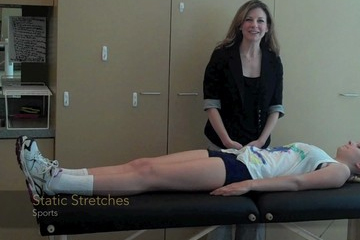
In this video, Mollee Smith, Physical Therapist at CHOC, helps to demonstrate sports static stretches to help prevent sports injuries.
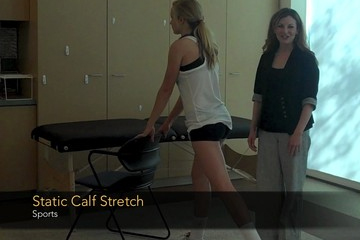
How to properly perform the static calf stretch is demonstrated by Mollee Smith, Physical Therapist at CHOC.
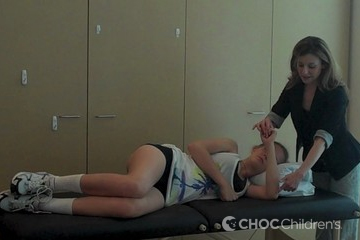
How to properly perform the sleeper stretch is demonstrated by Mollee Smith, Physical Therapist at CHOC.
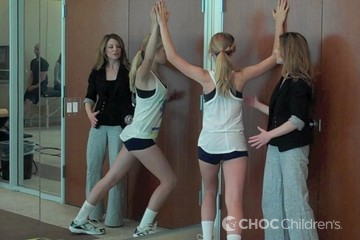
In this video, Mollee Smith, Physical Therapist at CHOC, helps to demonstrate the pectoralis stretch in the corner.

In this video, Mollee Smith, Physical Therapist at CHOC, helps to demonstrate the doorway pectoralis stretch.
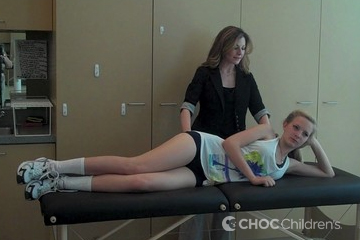
How to properly perform static quadracep stretches is demonstrated by Mollee Smith, Physical Therapist at CHOC.












